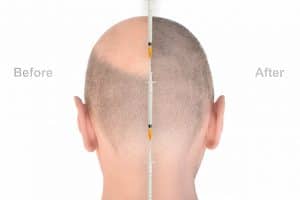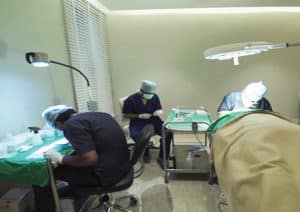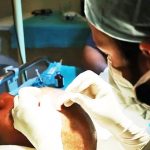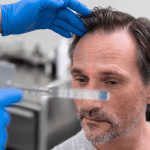What is the Difference Between Minoxidil and Finasteride?
Here are some unique features of Minoxidil and Finasteride that will enhance your understanding of these treatments:
- Mechanism of Action:
- Minoxidil: Primarily works as a vasodilator, increasing blood flow to hair follicles and stimulating hair growth directly at the scalp.
- Finasteride: Functions as a 5-alpha-reductase inhibitor, reducing the conversion of testosterone to dihydrotestosterone (DHT), a critical factor in hair loss.
- Form and Application:
- Minoxidil: A topical solution or foam applied directly to the scalp.
- Finasteride: Comes in pill form and is taken orally.
- Usage:
- Minoxidil: Typically applied twice daily to the affected areas of the scalp.
- Finasteride: Usually taken once daily as a tablet.
- Target Audience:
- Minoxidil: Suitable for both men and women experiencing hair thinning and loss.
- Finasteride: Primarily prescribed for men with male pattern baldness; not recommended for use by women due to potential hormonal effects.
- Onset of Results:
- Minoxidil: Users may start seeing results in 3 to 6 months, with continuous use required to maintain hair growth.
- Finasteride: It may take 3 to 12 months to see significant results, with ongoing use necessary to sustain benefits.
- Side Effects:
- Minoxidil Can cause scalp irritation, itching, and dryness. Systemic side effects are rare but may include dizziness or unwanted facial hair growth.
- Finasteride: Potential side effects include decreased libido, erectile dysfunction, and other sexual health issues; it can also cause hormonal imbalances.
- FDA Approval:
- Minoxidil: Approved by the FDA for both men and women to treat hair loss.
- Finasteride: The FDA approved this drug for men to treat androgenetic alopecia (male pattern baldness).
- Effectiveness:
- Minoxidil: Generally effective in promoting hair regrowth in the crown and vertex areas of the scalp.
- Finasteride: Highly effective in preventing hair loss and promoting regrowth in men, particularly in the crown and mid-scalp areas.
- Additional Benefits:
- Minoxidil: Can be used in conjunction with other hair loss treatments, such as hair transplants or low-level laser therapy.
- Finasteride: Also used to treat benign prostatic hyperplasia (BPH) due to its effects on DHT levels.
- Discontinuation:
- Minoxidil: Stopping use will likely result in gradually losing newly grown hair within a few months.
- Finasteride: Discontinuation can lead to the return of hair loss within a year as DHT levels increase again.
These points comprehensively compare Minoxidil and Finasteride, emphasizing their unique mechanisms, uses, and effects.

Finasteride and minoxidil are combination treatments for male- and female-pattern hair loss. Combination treatment refers to the use of certain medications together.
What is DSA in Hair loss diagnosis?
DSA stands for the Diagnostic System for Alopecia. We have developed the most comprehensive diagnostic framework using DSA. There are many distinct patterns of hair loss, which a wide range of factors, including environment, psychology, genetics, and diet, can cause. DSA looks at all these things to give each patient a comprehensive treatment plan.
Many causes, such as genetics, illnesses, and lifestyle choices, can contribute to hair loss:
Genetics
Male—or female-pattern baldness can be influenced by genes acquired from both parents. In men, this can lead to thinning hair at the top of the head, a receding hairline, and thinning hair over the crown of the scalp in women.
Changes in hormones
These can happen as a result of thyroid illness, menopause, pregnancy, or delivery. For instance, women who are going through menopause may lose hair because their bodies are producing less progesterone and estrogen.
Ailments
These can include autoimmune conditions like alopecia areata or fungal scalp infections like ringworm.
Action patterns
These can include tight ponytails, braids, and hair extensions; they can also include haircare products that harm hair, such as bleach or perms. Additionally, it may involve trichotillomania, or hair pulling, a condition in which the patient pulls their hair, giving the appearance of hair loss.
Stressful situations, some drugs, and dietary deficits are other factors that contribute to hair loss. Hair loss can be temporary or permanent, affecting the entire body or only the scalp. Some symptoms include a receding hairline, patchy hair loss, or general thinning. If you’re concerned about hair loss, you can help determine the kind and cause by consulting a dermatologist.
What is the DHITM Hair Transplant Procedure?
DIRECT HAIR IMPLANTATION (DHITM) – DHI is a unique hair transplant procedure that can only be performed by:
- DHITM Technique
- DHITM certified doctors
- DHITM protocols
- DHI’s patented instruments
- At DHI-authorized clinics
No pain, no scars, no downtime. The perfect natural result every single time.
Direct Hair Implantation – DHITM
In a procedure known as direct hair implantation (DHITM), hair follicles from one area of the scalp are extracted and then implanted into balding regions of the scalp. This technique is highly advanced compared with other hair transplant techniques like follicular unit extraction (FUE) and follicular unit transplant (FUT).
- During a DHI operation, a surgeon will use local anesthesia to numb the scalp and shave the patient’s head.
- A fine-point tool extracts hair follicles from the patient’s back of the head.
- Insert the grafts or hair follicles into the implanter using a hollow needle connected to a tube and plunger mechanism.
People of all genders, nationalities, and backgrounds can undergo a hair transplant using the DHITM—Direct Hair Implantation technique. This technique can treat crown hair loss, mid-parting thinning, and receding hairlines.
DHITM is regarded as the most excellent hair transplant method available worldwide. All procedures follow established regulations and are safe and painless. A DHI hair transplant typically starts from INR 1** Lakh onwards, depending on the patient’s needs and the extent of their baldness.
**Take a consultation at DHI clinics before deciding on a hair transplant. Think Hair Transplant Procedure Think DHI Technique
Direct hair transplant healing period
Direct Hair Implantation (DHI) hair transplant recovery timeframes vary; however, most patients experience an average reduction in discomfort one day after the surgery. You can resume light activity two days after the therapy, return to work three days later, and resume your daily routine after the fourth day; however, discuss with your doctor before exercising or outing.
While the healing process takes about two weeks, patients can resume their regular lives after a two-day rest period and are discharged the following day, thanks to the non-invasive nature of the DHITM Hair Transplant procedure. To alleviate discomfort, apply a cold compress to the swollen area while raising your head, and avoid sleeping on your stomach.
How long does hair take to grow back after the DHITM Technique?
The transplanted hair will gradually regrow at an average rate of 1-2 cm per month, eventually growing back thicker. The information above makes it clear that you will need to wait two to four months or more to notice any noticeable effects from your hair transplant, and it can take up to six months for those results to fully manifest.
How much of a success has DHI been?
The success of the surgery depends on grafts, the surgeon’s skill, and the patient’s postoperative instructions. Success rates for DHITM hair transplant procedures range from 90 to 97 percent.
How do you wash your hair after DHI?
Pour warm water into a cup and add a few drops of DHI hair and extra mild or normal shampoo. Use the soapy water to moisten your hair. Gently massage the area with soapy water, not disturbing the transplanted hairs. Refrain from picking at any potential scabs when washing.
What happens ten years after hair transplantation?
After ten years, the transplanted hair will (or should) still be there and grow out. The length of the results may vary depending on a few factors, such as how skilled your surgeon was and whether or not you followed the aftercare instructions.


At what age is a hair transplant the best option?
Therefore, waiting until age 24-25 to receive a hair transplant is better. There is a finite number of healthy hair follicles. A person may run out of healthy hair follicles before age 25, meaning they need hair transplants when they’re 40. However, in DHI clinics, most clients are below 65 years of age; the only condition is that the clients have a suitable donor area.
Simple Financing Options from DHI for Hair Transplant Therapy
Thanks to various financing alternatives, hair restoration procedures at DHI are now even more convenient and reasonably priced. We provide EMI plans with 0% interest.
Simple Financing Options from DHI for Hair Transplant Therapy
If our simple finance plans interest you, complete the online application on our website to schedule a consultation and receive further information. You can also ask to be called back.
Many believe the DHI hair transplant cost is a little high. Because of this misperception, they trust uncertified clinics. It would help to consider the long-term repercussions of getting an inexpensive hair transplant in cheap hair transplant clinics. These inexpensive operations result in artificial-looking scars that last a lifetime. Surgeons have restricted functions and need more certification. Patients’ safety is in danger since the surgeons at these clinics utilize reused, subpar Chinese tools. Furthermore, the follicle survival rate is less than 50%, while DHI offers a rate above 90%.
The Price of your DHI Hair Transplant Treatment will be determined by the Following:
- Count of grafts or hair follicles needed to fill up bald spots
- State of hair loss
- Donor hair’s texture, colour, and other attributes
- A DHI hair transplant session typically finishes in a few hours and is a lunch-hour break procedure. Multiple sessions could be needed in some circumstances to get the desired effects.
DHI HAIR TRANSPLANT COST
The cost of a hair transplant is one of the most crucial considerations when weighing your alternatives. The cost of the operation at DHI is as distinct as you and your course of therapy for hair loss.
What is the Price of a Hair Transplant?
The cost of a hair transplant is mainly determined by the number of grafts or hair follicles needed to provide a patient with the most significant outcomes. As a result, providing a precise quote over the phone or online is not feasible.
We invite you to schedule a thorough hair and scalp consultation with our specialists at our clinic in your area. The doctor will be in a better position to estimate the precise procedure cost after your appointment.
We recommend you visit one of our 13 clinic locations in India to find out the precise cost of a DHI hair transplant, or you can call us at +91 84 7100 7200 to talk with a hair specialist.






